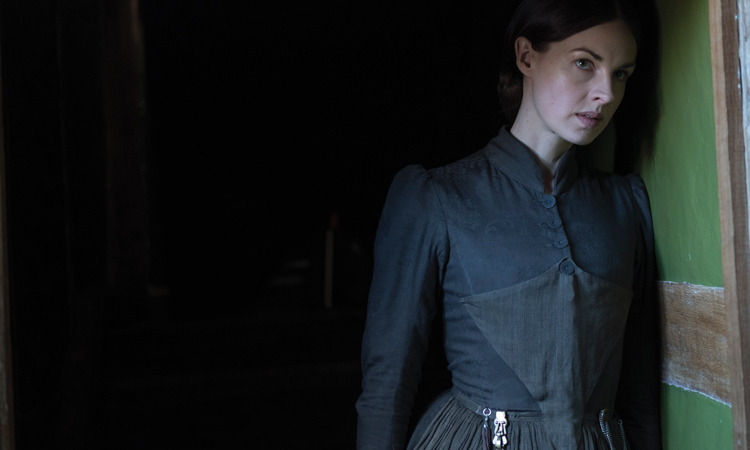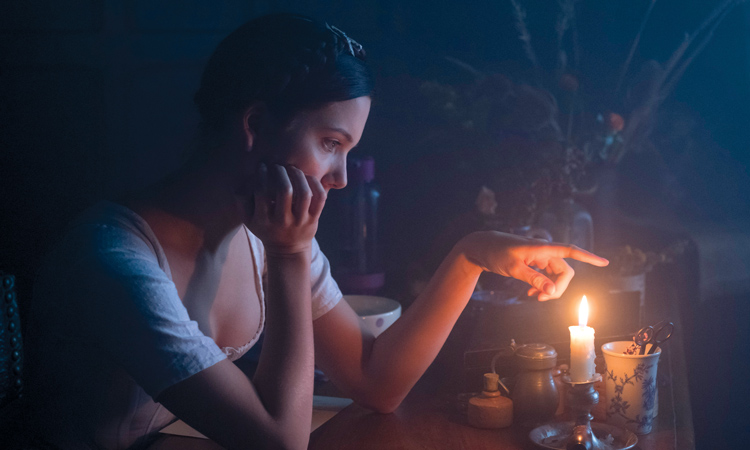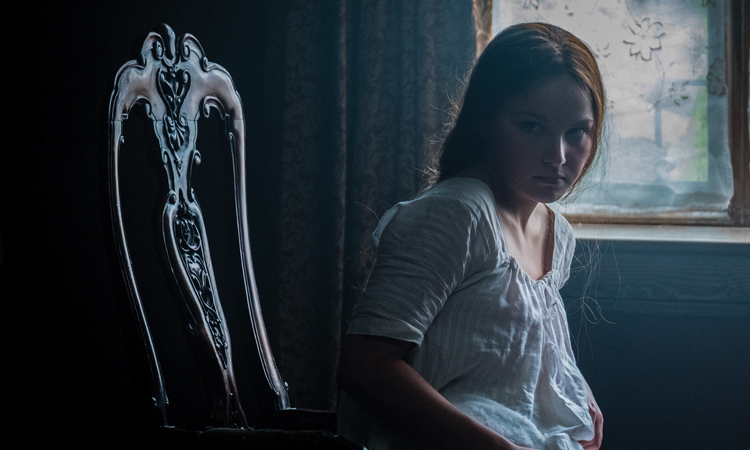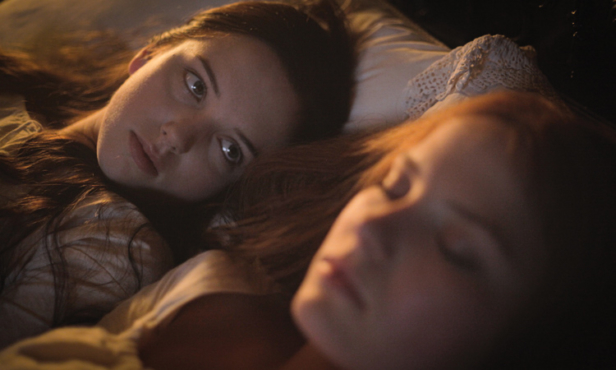Joseph Sheridan Le Fanu’s 1872 Gothic novella has a long history of adaptation and reinvention in cinema. In 1932, Carl Dreyer’s Vampyr stripped away the lesbian erotica, in the Sixties, horror legend Christopher Lee starred in a good-looking but barely coherent Italian version of the text called Terror In The Crypt, Hammer Horror had a stab at it in 1976, with The Vampire Lovers, starring Peter Cushing and Ingrid Pitt, and the 1972 Spanish film, The Blood Splattered Bride, has been hailed as a cult classic for its X-rated but progressive, feminist handling of Carmilla’s themes.
In 2020, director/writer Emily Harris’ interpretation hits UK cinema screens. Filmed in 2017 at an Elizabethan manor house in East Sussex, she transposes the time to the 1780s and relocates to rural England.
The film strikes an eerie ambiance from the start, introducing its isolated, 15-year-old protagonist Lara (Hannah Rae) as a captive of sorts to her stern governess, Miss Fontaine (Jessica Raine). When a horse and carriage crash brings an auburn-haired mysterious stranger, Carmilla (Devrim Lingnau), to their door, Miss Fontaine’s suspicions and superstition lead her to believe she is in fact the devil.

“I’d never actually read the book before, so when I did, I found that aspects of it really intrigued me, which I felt hadn’t been expressed in cinema before and that made me want to make it,” explains Harris. Her previous background in theatre gave her a fresh approach to the adaptation: “Having worked in theatre as an interpretive art form I didn’t have an aversion to something being done before. You can see the same thing being interpreted in different ways so that in itself was exciting; seeing what my version would be.
“At the time I came to it, it was reflecting a lot of what was happening in the world in terms of how we were behaving as a society and those aspects of human nature that were coming to the fore were very obvious to me in the book. It felt like the right time to explore it in this way, to look at how prejudice and hate towards an outsider has become so ingrained as part of normal life. We’ve started to accept that as the norm.”
Themes of fear, persecution and sexual awakening are key in Carmilla. As far as the fantasy and vampiric elements go, Harris decided to take her interpretation in a new direction. “I tried to really think about, what is a vampire? Where does the vampire come from in literature and what does it represent?” she says. “For me, a vampire has always represented the feeling of being in love. That feeling, when you have fallen deeply in love, and you just want to find a way to keep the person or create a mutual pact! I guess that’s really weird, but it’s just this visceral urge where you just want to attach to somebody and make sure they’re yours forever and ever. I really relate to vampirism in that way, which isn’t actually scary it’s just very practical. I guess what I was seeing in Carmilla was definitely that first coming-of-age moment of love. I was trying to reflect first love and using that idea of vampirism in that way. So, it’s not this scary thing, it’s a feeling.”
Harris’ conversations with Hannah Rae on set mainly focused on loss of innocence, first love and coming-of-age. “The way that we saw the relationship between Carmilla and Lara was very innocent,” explains Rae. “Lara hasn’t grown up with a lot of interaction with other kids her age. When Carmilla is introduced, it’s like her coming-of-age, through their relationship, finding out who she is and how she deals with the situation. She’s never experienced a girl like her, her own age before. We had lots of chats about the film, and I drew on my own experiences of being a 15-year-old and trying to find out who I am.”

Phil Selway from Radiohead (who also has themes and music from Legion, The Handmaid’s Tale and iZombie under his belt), composed the score for Carmilla. “He came on board very early,” says Harris. “The score and sound design are half the film so it was important that it wasn’t left until the end of production. He had read the script very early on as he’s a percussionist which I felt, from a storytelling point of view, made initial sense. When he read the screenplay, he said there was so much percussion in the script with the crunching leaves, crashing rain and crackling fire, so he developed a score that elevated the story. He gave it an element that I hadn’t even thought about. He came on set and he absorbed the environment. The score definitely underpins all of the emotional arc that we were trying to get at.”
Harris introduces the world of Carmilla by juxtaposing rigid routine with the wild abandon of the natural surroundings. The interiors at night are all lit by candle and by day only natural light pierces through the windows. Gerrit Dou’s paintings are a touchstone for the way the images are framed and Harris cites Peter Weir’s Picnic At Hanging Rock and Lucile Hadzihalilovic’s Innocence as key references for the atmosphere and feel of the film. “Innocence was a big influence on me when I saw it, and how she tapped into that coming-of-age moment in a female’s life in a really beautiful way and also created a world that you just believe. Picnic At Hanging Rock is driven by this need for companionship more than lust and that need to be understood. It’s something that is quite beautiful about how Lara and Carmilla relate to one another. That age group, there’s a difference between being understood and understanding, and I think the need here is to be understood. Lara doesn’t mind that she doesn’t understand Carmilla, she just feels understood. I think that’s the beauty at the heart of it.”
That’s not to say that Lara doesn’t have dark carnal desires though. Her burgeoning emotions are placed in visceral erotic dream sequences that occasionally pierce her oppressive reality. “The dream sequences are so bloody and gory,” exclaims Rae. “The thing Emily and I were talking about, was that although Lara seems quite innocent and young, she does have this dark curiosity inside her. There’s the dream sequence where I’m being sawn in half so it shows how her desires are transforming from her attraction to a man to Carmilla. It’s her inner turmoil that she can’t express as she’s so repressed and contained by Miss Fontaine.”

An earlier sequence places Lara in charge of her sexual cravings and fully on top of a local magician who she seems to have a crush on. “The dream you’re thinking about is the one where she almost enters the magician through his chest,” laughs Harris when I suggest how powerful a depiction it is of untamed, penetrative female longing. “She’s having a sexual awakening; these feelings and thoughts are transferring into her dreams. She’s peeling off the layers of clothes from this magician character that she’s infatuated with. It’s almost as if she can’t get enough of him! Like, peeling his clothes off isn’t enough so she has to keep going deeper and deeper inside of him, which is a dream logic in a sense. It’s not meant to be nasty or mean, it’s actually meant to be visceral and sexual. Lara just wants more, more, more! She literally goes into him!”
The LGBTQ themes that subtly ripple through the film in this candid exploration of sexuality that shows how desires can shift were not something that Harris was initially focused on. “It wasn’t something discussed on set, but I’ve noticed that it has come to the fore as the film has been out there with the public, and it definitely has that aspect to it,” Harris says. “I don’t know if this is a good thing or not, but honestly, I was looking at first love and it didn’t matter at the time of writing it what gender that was. It’s set in a time when female sexuality was repressed, Lara’s absolutely isolated and everything she’s learnt comes from Miss Fontaine, who is really trying to stop her from growing up.” The impetus was on the importance of Lara coming-of-age on her own terms. “First love doesn’t necessarily come with identifying your sexual orientation. That exploration of first love can come in any shape or form.”
Rae concludes by explaining what Carmilla means to her, and what she hopes an audience will take away from it: “It’s okay to be different. People are scared of what they don’t understand or things that are out of the ordinary. Different isn’t bad. This different girl that came into Lara’s life is probably also one of the best things that has ever happened to her.”
Carmilla is in cinemas on 16 October and on-demand from 19 October.
